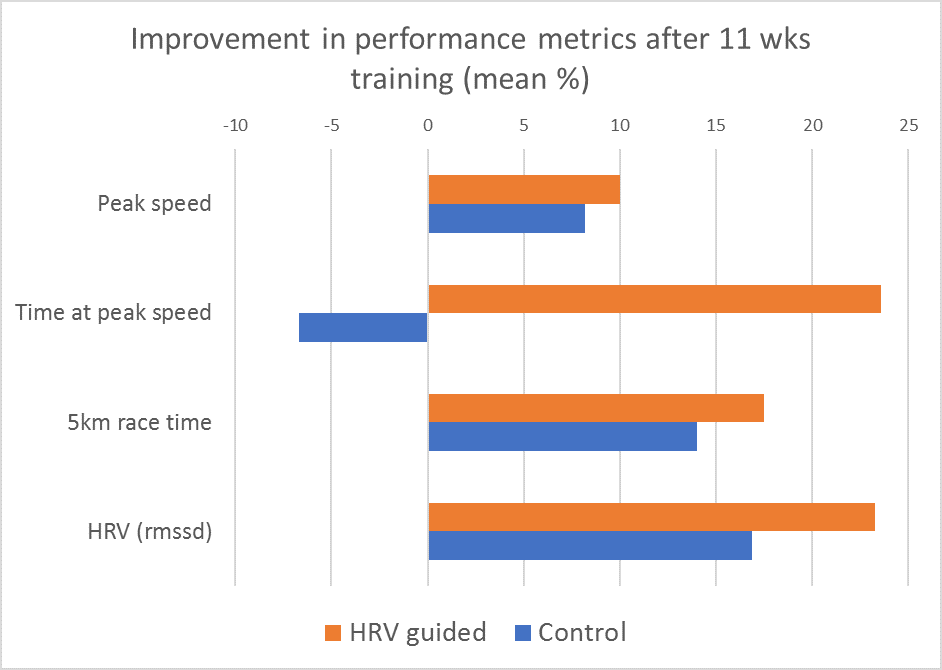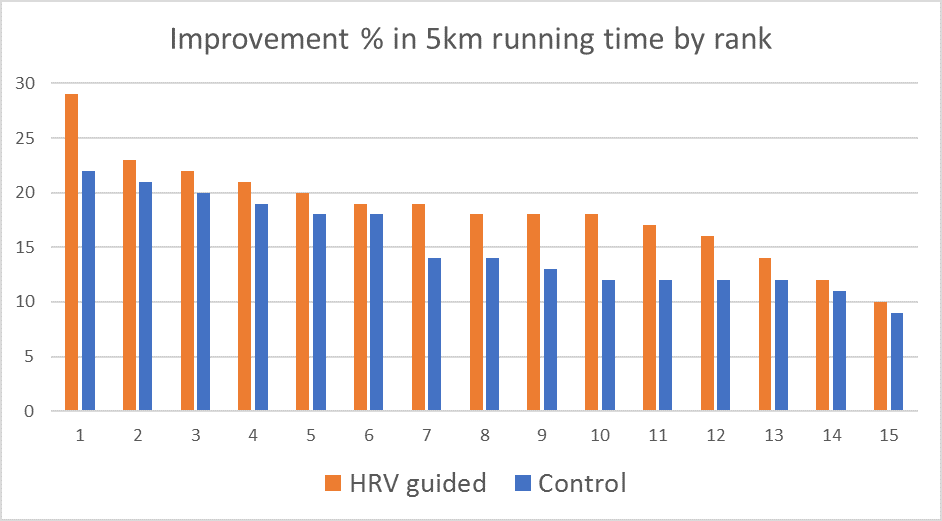Who, what & why
One of the papers that inspired me when starting ithlete in 2009 was ‘Endurance training guided individually by daily Heart Rate Variability (HRV) measurements’ by Antti Kiviniemi. He showed that when male club runners performed high intensity training on days their HRV was at or above mean value, and lower intensity or rest when their HRV was significantly below baseline, they improved their maximum running speed more than comparable runners on a standard coach led training program. Although this showed good potential for HRV guided training, the algorithm for deciding what to do on a given day was complex, and the same author was unfortunately not able to show the same benefits in women in a subsequent study.
Now, nearly 10 years later, a new study conducted jointly by sport scientists in Brazil and Canada has shown that this need not be the case, and that even runners starting out on beginners’ programs like Couch to 5k can benefit very significantly from using HRV to guide their training.
What did they do
They recruited 36 female subjects who were not previously regular runners, but who were healthy and able to complete a 5km run in less than 45 mins. Subjects were randomly allocated to either an HRV guided training group or a control group. 30 of the subjects (15 in each group) successfully completed the 11 week training program.
- An initial baseline assessment included determining the participants’ peak running speed on a treadmill. This baseline assessment was repeated half way through the program to update the target running speeds during training.
- HRV measurements (RMSSD) were made in the standing position, both at baseline and on training days (3x per week).
- The training programs differed for the HRV guided and control groups as follows:
Control group: Odd weeks – two medium intensity, one HIIT sessions, even weeks – two HIIT and one medium intensity sessions.
HRV guided: Comparison between the value on each training day compared to the average of up to 10 readings was used to determine whether HIIT or medium intensity sessions would be prescribed.
- Training was performed three days per week either afternoons or evenings to accommodate individual schedules, and in a departure from the usual recommendation, HRV assessment was performed immediately before training. The reason for this was so that stresses of daily life since waking could be taken into account in determining whether the session should be HIIT or lower intensity. All sessions were preceded and followed by 10-15 min warmup and cooldown.
The HRV Guided Training Plan
For High intensity training (HIT) sessions participants were asked to perform equally timed intervals and recovery. Intervals were at 100% individual peak running speed as measured during the baseline assessment. An example might be 5 x 3 mins running and 3 mins recovery jogging, for a total of 30 mins.
If the day’s HRV was more than 1 standard deviation below the mean, medium intensity was prescribed. This was defined as 75% of their individual peak speed, during the first 5 weeks this was for 30 mins, increasing to 40 mins in later weeks. Participants could perform a maximum of 4 consecutive HIIT sessions before a medium intensity one would be prescribed to alleviate monotony.
What did they find
Although there were no differences between the two groups in any body measurements, starting performance, diet or number of completed training sessions, there were significant differences in the results:

- Peak speed improved 10% in the HRV group vs 8% in the control group.
- Time at peak speed only improved in the HRV group.
- 5 km time improved an average of 17.5% in the HRV group vs 14% in the control group.
- This represents a reduction of 6.5 mins for the HRV group vs 5 mins for the control group.
What is really remarkable about the result in 5 km time though is that when analysed by pair of runners from the one making the greatest improvement to the one making the least, the HRV group outperformed every time:

Finally, HRV itself improved more in the HRV guided group, by a significant 23% in the raw rmssd measure (5 units on the ithlete 20xLnRMSSD scale).
What does it mean
This study puts HIIT for recreational runners into action, using HRV to select the days when the participants bodies were best equipped to both tolerate and benefit from high intensity intervals. The HRV guided group ended up doing significantly more HIIT sessions than the control group, but any prescribed training plan would have to err on the side of caution when prescribing a number of HIIT sessions per week, especially in the case of less experienced / novice runners in order to avoid injury and potential overtraining.
What is most notable about this study is that every participant using HRV guidance improved more than their ranked equivalent in the control group.
The relatively simple protocol also makes this technique highly applicable even to self-coached runners, armed only with a smartphone and preferably a running watch capable of showing pace, based on either stride length or GPS.
Look forward to a series of articles coming soon on how exactly to apply this step by step with ithlete, including experience from our very own in-house guinea pigs!
Endurance Running Training Individually Guided by HRV in Untrained Women
DF da Silva et al. Journal of Strength and Conditioning Research. 2017 May 30.
